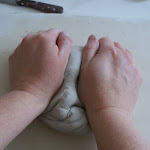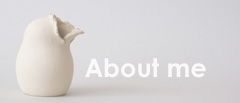Usually you work with clay plaques and that's what I'm going to do too!
First I'll show you how to make the mould, which is a piece of cake, and then I'll make a little plate that you can use for fruit, chocolates, tealightholders,...
Here is what you need: a bowl, liquid bees wax, paintbrush, plaster, container to mix plaster. I usually use old ice cream containers because that allows me to eat icecream! :)
 Take some liquid bees wax and brush it into the surface of the bowl. This will make sure that the plaster won't get stuck on the glass.
Take some liquid bees wax and brush it into the surface of the bowl. This will make sure that the plaster won't get stuck on the glass. Make some plaster ready in the plastic container. Mostly it is made with 1 part of water and 3 parts of plaster but it depends on the kind of plaster you use.
Make some plaster ready in the plastic container. Mostly it is made with 1 part of water and 3 parts of plaster but it depends on the kind of plaster you use.I always go with the pyramid method: you poor the plaster into the water at the same place and a pyramid will form. When the pyramid doesn't suck any water anymore, it's enough plaster and you can start mixing it with the water.
If you like that the plaster will set quickly, you can use lukewarm water or add a pinch of salt.
 Mix the plaster with the water. If you don't want rough hands, you better wear gloves.
Mix the plaster with the water. If you don't want rough hands, you better wear gloves. Then poor the plaster in the bowl.
Then poor the plaster in the bowl. Shake a little bit with the bowl so that the airbubbles that are in the plaster can come out. Let it set for about an hour.
Shake a little bit with the bowl so that the airbubbles that are in the plaster can come out. Let it set for about an hour. Then you can take the mould out of the bowl. It's a perfect round & very smooth. It's still damp and needs to dry a few days befor you can use it. I usually put it in the sun,on the radiator or on the lid of the kiln so that it dries quicker.
Then you can take the mould out of the bowl. It's a perfect round & very smooth. It's still damp and needs to dry a few days befor you can use it. I usually put it in the sun,on the radiator or on the lid of the kiln so that it dries quicker. The mould is dry so now we can use it. Take a piece of clay.
The mould is dry so now we can use it. Take a piece of clay. Put it in between two wooden sticks.
Put it in between two wooden sticks. Use the rolling pin to roll the clay flat.
Use the rolling pin to roll the clay flat. When the clay is rolled out, make it a bit smooth with an old credit card.
When the clay is rolled out, make it a bit smooth with an old credit card.  Then place a square piece of paper on top of it and cut away all the edges so that a nice square remains.
Then place a square piece of paper on top of it and cut away all the edges so that a nice square remains. I usually put flat pieces on a flat plate of plaster and go over it with a credit card again so that there are no bumps.
I usually put flat pieces on a flat plate of plaster and go over it with a credit card again so that there are no bumps. Then you take the square and drape it over the mould.
Then you take the square and drape it over the mould. The mould will suck the water out of the clay & the shape will remain.
The mould will suck the water out of the clay & the shape will remain.After a few hours, you can take the dish away from the mould and it looks like this.
 I'm too impatient to show it to you when it's fired & glazed, so I just put some chocolates on there so you can see how it will look when it's totally done! :)
I'm too impatient to show it to you when it's fired & glazed, so I just put some chocolates on there so you can see how it will look when it's totally done! :) You can also use the mould in a different way to make a bowl.
You can also use the mould in a different way to make a bowl.When the clay plaque is rolled out, you drape it onto the mould.
 Then take a little wet sponge and press it gently against the mould.
Then take a little wet sponge and press it gently against the mould. Take away some of the excess clay around the mould.
Take away some of the excess clay around the mould. Then with a soft rib you go over the clay plaque and press it gently against the mould and make it all smooth.
Then with a soft rib you go over the clay plaque and press it gently against the mould and make it all smooth. Cut away the excess clay.
Cut away the excess clay. Finish the edges smoothly with the soft rib and let it dry slowly upside down.
Finish the edges smoothly with the soft rib and let it dry slowly upside down. This bowl holds even more chocolates I think! :)
This bowl holds even more chocolates I think! :)









